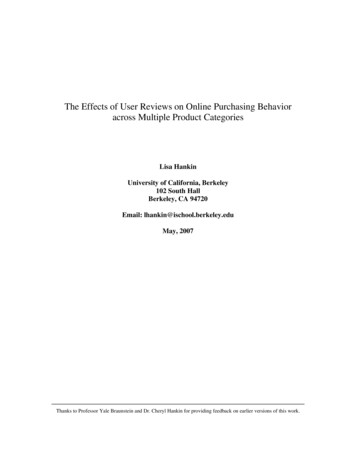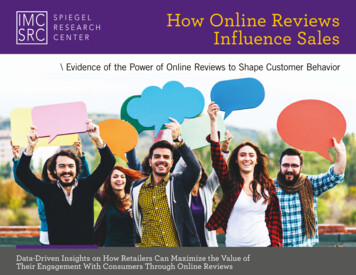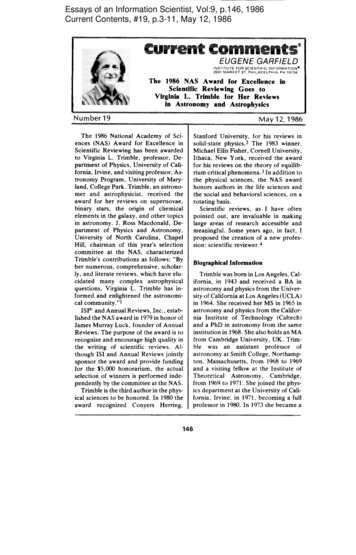
Transcription
The Effects of User Reviews on Online Purchasing Behavioracross Multiple Product CategoriesLisa HankinUniversity of California, Berkeley102 South HallBerkeley, CA 94720Email: lhankin@ischool.berkeley.eduMay, 2007Thanks to Professor Yale Braunstein and Dr. Cheryl Hankin for providing feedback on earlier versions of this work.
Table of ContentsDefinition of Terms . 31. Introduction. 52. Literature Review . 7Seller Reviews . 7Association between Positive or Negative Feedback and Product Price . 8Association between Positive or Negative Feedback and the Probability of a Sale 10Association between Duration of Sellers’ Experience and Price . 10Product Reviews . 12Experiential Products . 14Expert/Critic Reviews . 14User Reviews. 163. Hypotheses . 19Seller Reviews . 19Product Reviews . 20Experiential Reviews . 204. Methodology . 215. Results . 23Participant Demographics. 23Importance of User Reviews. 24High Level Findings . 25Seller Reviews . 26Product Reviews . 29Experiential Reviews . 316. Conclusions and Design Recommendations . 347. References. 378. Appendix. 412 of 52
Definition of TermsExpert ReviewsReviews written by paid professionals. Movie critics and consumer reports areexamples of expert reviews.User ReviewsReviews written by consumers for no monetary compensation. Reviews written forbuyers or sellers on eBay or consumer recommendations on Amazon are examples ofuser reviews.Product CategoriesA collection of similar types of products. Household Products, experiential products,sellers, and services are all examples of different product categories.Household ProductsThis product category includes tangible products typically found in a household.Items such as appliances, electronics, or equipment fit into this product category.Experiential ProductsProducts that are consumed solely for the pleasure and experience that they provide.Items such as movies, music, or fine food fit into this product category.Seller ReviewsA review given to a seller by a buyer after a purchase is completed. Seller reviews canbe found on websites that offer products by several different sellers or stores (such aseBay or CNET).3 of 52
Product AttributesElements associated with a typical product for sale online. Price, image, and averagerating are all examples of a product attribute.User Review AttributesElements associated with a typical user review found online. Average rating, numberof reviews, and helpfulness score are all examples of a user review attribute.WOMWord-of-Mouth references the act of passing information, especially recommendations,in an informal person-to-person manner. This is traditionally done in a face-to-facesituation.eWOMElectronic Word-of-Mouth references the traditional WOM practice conductedonline, via email, text messages, or online forums.4 of 52
1. IntroductionBefore consumers decide on a specific item to purchase, they learn about others’ pastexperiences through word-of-mouth (WOM). Today, the internet has replaced traditionalface-to-face WOM and has created a new electronic WOM platform (eWOM).Consumers now have a breadth of information at their fingertips and can accessthousands of user reviews online.Online user reviews have become increasingly important as consumers continue topurchase products online. When consumers are not able to judge a product in person,they often rely on this eWOM transfer to mitigate risks regarding product quality and thetruthfulness of the seller. A study conducted on the BizRate website (a popular userreview website) found that 44% of respondents consulted an opinion site before making apurchase and 59% indicated that they considered user-generated reviews more valuablethan expert reviews. 1 More recently, DoubleClick’s yearly Touchpoints survey hasshown that websites provide the single greatest influence to online consumers whenmaking shopping decisions. 2Past research has focused on the effects of positive and negative reviews within specificpurchasing situations. For example, extensive research has been performed on eBay’sreputation system. This system relies on buyers and sellers to rate each other’sperformance and enables a low cost mechanism to enable trust among the virtuallyanonymous transactions. Additionally, significant research has been conducted on theeffects of user and critic reviews for movies and books on purchases.The present study investigates the impact of user reviews on purchasing decisions acrossmultiple product categories. Specifically, participants were asked to make purchasing1Piller, C. (1999), “Everyone is a Critic in Cyberspace,” Los Angeles Times (Dec. 3)2DoubleClick Touchpoint IV: How Digital Media Fit into Consumer Purchase Decisions. (2006)5 of 52
decisions regarding sellers, household products, and experiential products, given thesame set of user reviews. The results will reveal if consumers treat user reviews similarly,irrespective of the product type.The paper is presented as follows. Section 2 presents an overview of published researchregarding purchasing decisions across seller, experiential, and household products.Section 3 presents research hypotheses followed by a description the researchmethodology (Section 4). The results of this study are presented in Section 5, followedby the conclusion and design considerations (Section 6).6 of 52
2. Literature ReviewA literature review that centered on user and expert reviews across three productcategories: sellers, products, and experiential products was conducted. The research wasfound in economic journals, marketing texts, and human computer interaction studies.The majority of the research cited has attempted to draw conclusions on the effects ofexpert or user reviews on a product’s price and probability of a sale. A synopsis of theresearch findings has been compiled and entered into a table found within each sectionbelow. These tables help illuminate the contradictory findings across the discreteresearch studies.Seller ReviewsOnline reputation systems are essential for online auction sites such as eBay. Buyers relyon seller feedback scores to mitigate the risks they face when conducting onlinetransactions with unknown sellers. By providing detailed information on sellers’previous transactions, buyers can start to make informed decisions regarding how theyproject the sellers to behave during their own transactions.Seller reputation systems are an unusual form of online reviews due to the fact thatreciprocity is encouraged; as a part of the eBay purchasing process, buyers areencouraged to rate their sellers and in turn sellers are encouraged to rate their buyers.This feedback exchange can help account for the unusually high average ratings acrossthe site: more than half of buyers rate sellers and over 60% of sellers rate buyers. Whilethe actual number of reviews is high, 99% of all feedback left on eBay is positive and7 of 52
only 1% is neutral or negative 3 . This overwhelmingly positive skew has been attributedto inflated feedback stemming from a fear of retribution. Buyers and sellers would rathergive a positive review or leave no feedback than risk having the other party tarnish theirown score in retaliation.A majority of the research done on seller reviews is centered on seller reputation systems,specifically on the eBay platform, and many attempt to forecast the price of an item basedon a seller’s previous performance. Table 1 compares the findings from 15 studies on theeffects of reputation on sales price.Association between Positive or Negative Feedback and Product PriceOverall, research has shown that sellers who have a positive reputation can command ahigher price for goods. However, several studies have found that reputation has no effecton sales price. These contradictory findings may be attributed to the large number ofdifferent items for sale on eBay and the associated variation in price and availability. Forexample, one study (which focused on gold coins that had an average selling price of 33) found that positive feedback was associated with a higher overall price whilenegative feedback was associated with an overall lower price and a reduction in theprobability of a sale. In contrast, another study (that tested the market of electric guitarson eBay, with an average selling price of 1,621), found that the only association wasbetween negative feedback and a higher price and reduction in the probability of a sale.3Resnick, P., and Zeckhauser, R. (2001), Trust among strangers in internet transactions: Empirical analysisof eBay's reputation system. Technical report, University of Michigan.8 of 52
Table 1: Sellers – Association between Positive or Negative Feedback and Product PriceAuthor(s)Item(s) for SaleAverage SellingPositiveNegativePriceFeedbackFeedbackBa, S.,Pavlou, P.CDs, Software, VideogamesHardware,Electronics 15.00 2000.00priceCabral, L.,Hortacsu, A.Gold CoinsCoins Proof SetIBM Thinkpad1998 Holiday TeddyBeanie Babies 50.00 78.00 580.00 10.70pricepriceDewally, M.,Ederington, L.30 Silver Age ComicBooks 357.00pricepriceDewanw, S.,Hsuz, V.Stamps 33.07pricepriceEaton, D.Paul Reed SmithGuitarsNo effectpriceHouser, D.,Wooders, J.Intel Pentium III 500Mhz 220.00pricepriceJin, G.Baseball TradingCards 165.50Kalyanam, K.,McIntyre, S.Palm Pilots 230.76pricepriceLivingston, J.Golf Clubs 409.96priceNo effectLucking-Reiley, D.,Bryan, D.,Prasad, N.,Reeves, D.Pennies 173.20McDonald, C.,Slawson, V. C.Harley-DavidsonBarbie Dolls 263.21pricepriceMelnik, M.,Alm, J. 5 US gold coins 32.73pricepriceMelnik, M.,Alm, J.US Silver MorganDollars 93.39pricepriceResnick, P.,Zeckhauser, P.Rio MP3Britannia BeanieBabies 141.93 122.45No EffectNo EffectResnick, P.,Zeckhauser, R.,Swanson, J.,Lockwood, K.Postcards 14.99No effect(new sellers)No effect(new sellers) 1,621.009 of 52No EffectNo EffectNo Effectprice
Association between Positive or Negative Feedback and the Probability of a SaleTable 2 compares the findings from 6 studies of the association between Sellers’reputation and the probability of a sale. Again, there is an overall trend that a higherpositive feedback score is associated with an increase in the probability of a sale and alower feedback score is related to a decrease in the probability of a sale. However, a fewstudies have found that the feedback score has no effect on sales or bids.Table 2: Sellers – Association between Feedback Score and the Probability of a Sale or Number ofBidsAuthor(s)Item(s) for SaleAverage , L.,Hortacsu, A.Gold CoinsCoins Proof SetIBM Thinkpad1998 Holiday TeddyBeanie Babies 50.00 78.00 580.00 10.70salessalesDewanw, S.,Hsuz, V.Stamps 33.07salessalesEaton, D.Paul Reed SmithGuitarsJin, G.Baseball TradingCards 165.50salesLivingston, J.Golf Clubs 409.96salesMcDonald, C.,Slawson, V. C.Harley-DavidsonBarbie Dolls 263.21bidsbidsPaul Resnick, P.,Zeckhauser, P.Rio MP3Britannia BeanieBabies 141.93 122.45salessalesNo effectsalessalesNo effectAssociation between Duration of Sellers’ Experience and PriceBuyers also seem to place considerable value in the duration of sellers’ activity as theyhave been found to pay 8.1% more for sellers with a substantial history of previous10 of 52
transactions (200 transactions) compared to new sellers with no experience on eBay 4 .Similarly, one study examining golf clubs on eBay found that sellers with more than 675positive comments earned a premium of 45.76 more than the average median pricecompared to sellers with no feedback 5 .Table 3 compares the research findings from studies that investigate the effects of thenumber of reviews submitted by buyers on product prices. These studies showed apositive association between higher numbers of reviews and higher selling prices. Thesefindings support the theory that buyers prefer established sellers rather than sellers whoare new to the practice.Table 3: Sellers – Association between Number of Reviews Submitted and Selling PriceAuthor(s)Item(s) for SaleAverage SellingLarge numberSmall numberof Reviewsof ReviewsPriceDewally, M.,Ederington, L.30 Silver Age ComicBooks 357.00pricepriceKalyanam, K.,McIntyre, S.Palm Pilots 230.76pricepriceResnick, P.,Zeckhauser, R.,Swanson, J.,Lockwood, K.Postcards 14.99priceprice4Resnick, P., Zeckhauser, R., Swanson, J., Lockwood, K. (2002), The value of reputation on eBay:A controlled experiment. Working paper, University of Michigan.5Livingston, J. (2002), How valuable is a good reputation? A sample selection model of internetauctions. Working paper, University of Maryland.11 of 52
Product ReviewsThere is an overall lack of research that focuses solely on product reviews, which can beattributed to several factors. Firstly, ‘product reviews’ is a very large category whichincludes most non-experiential tangible products (such as household goods andelectronics). Secondly, most researchers tend to look at products within another domain.For example, studies on the eBay platform usually center on a specific product such asgolf clubs or gold coins.This small body of research suggests that consumers depend on online user reviews toresearch products before purchasing. This is especially true when consumers stray fromknown brands 6 or are considering buying products outside their expertise. One studynotes that consumers give more credence to negative information that is received viaWOM 7 but that consumers want to understand the negative reviews in order to decide ifthe reviews align with their own concerns.There has been a breadth of research conducted on a variety of different product typeswithin eBay. After reviewing Table 1 and 2 which assembles the research done on theeBay reputation system, one can see the variation in product types range frominexpensive collectibles to high-end consumer electronics. It is possible that some of the6Chatterjee, P. (2001) Online reviews: do consumers use them? In M.C. Gilly and J. Meyers-Levy(eds), Advances in Consumer Research, Vol. 28. Ann Arbor, MI: Association for Consumer Research, pp.129–33.7Mizerski, Richard W. (1982), "An Attribution Explanation of the Disproportionate Influence ofUnfavorable Information," Jozirnal of Consumer Research, 9 (December), 301-31012 of 52
contradictions found within Seller’s Reviews literature could be due to the products thatwere listed.One of the fifteen eBay items, the electric guitars, for sale in Table 1 exhibited an unusualresult when compared to the rest of the products for sale. The Paul Reed Smith Guitarsare high-end musical instruments which are relatively expensive and harder to find thanother products in similar studies. One explanation for this finding is that buyers arewilling to give seller’s more benefit of the doubt when they purchase rare high-end itemsor that perhaps the items were so specific and hard to find that the buyers were willing tolower their expectations of the seller in return for purchasing the ideal item. One canhypothesize, that these findings may extend to product reviews as well; buyers consider aproduct’s reputation only as part of their overall purchasing decision and are not bound toa perfectly rated product if other factors make the item more attractive.13 of 52
Experiential ProductsExperiential products differ from traditional consumer products insofar as they areconsumed solely for the pleasure and experience they provide. While traditionalconsumer products tend to be chosen on the basis of utilitarian needs, experientialproducts like movies, books, or music, are consumed for hedonistic purposes (Holbrookand Hirshman, 1982). For this reason, online reviews are very important whenconsumers are choosing products they do not have first-hand experience with. Otherconsumers or experts can provide their own impressions after having experienced theproducts and the purchaser can begin to make more informed decisions. In fact, onestudy found that nearly half of young internet users rely on user review systems to makeexperiential product purchases like CDs and DVDs. 8 Similarly, Senecal and Nantel(2004) 9 conducted a study across multiple product categories and found that consumersrelied on recommendations for experiential products significantly more than other typesof products.Expert/Critic ReviewsA majority of the research regarding experiential products focuses on the movie industry.This research examines the predictive value of expert reviews on future box office sales;as such, movie critics are depicted as either influencers or predictors. Elisahberg andShugan (1997) found that positive critic reviews were associated with long-term, but not8Godes, D. and Mayzlin, D. (2003) “Using Online Conversations to Study Word of mouthCommunication,” Yale SOM working paper.9Senecal, S. and Nantel, J. (2004) The Influence of Online Product Recommendations on Consumers’Online Choices. Journal of Retailing 80, 159-6914 of 52
immediate, box office success; these findings suggest that critics are predictors, but notinfluencers, of box office revenue. This result can be explained by the nature of theexperiential product. While reviews help consumers make experiential product decisions,consumers do not solely rely upon these reviews unless they have confidence that thereviewer is enough ‘like them’. Although a consumer currently has access to manyexpert reviews online, he or she only accepts reviews written by critics who are mostsimilar to that consumer.In general, positive critic reviews are associated with higher sales and negative reviewsare seen to hurt sales of experiential products (Chevalier and Mayzlin 2006). However, astudy based on New York Times book reviews conducted by Sorensen and Rasussen(2004), found that while positive reviews were positively associated with sales, evennegative reviews were associated with increased book sales. The authors suggested thatpublication of a review, regardless of its content, creates general awareness (i.e. “anypublicity is good publicity”). Sorensen and Rasussen’s findings appear to extend to criticreviews for movies. For example, the widely panned movie Wild Hogs brought inrevenue of nearly 40 million dollars during its opening weekend compared to thecritically acclaimed movie, Zodiac, which brought in slightly over 13 million dollars. 10Moreover, in some cases, negative reviews may in fact create controversy which fuels thereader’s interest. Table 4 displays the overall results of a literature review focusing onthe association between critics’ reviews and box office revenue.10Boxofficemojo.com (weekend box office for ?view &yr 2007&wknd 09&p .htm15 of 52
Table 4: Experiential Products – Association between Expert/Critic Reviews and Effects on SalesAuthor(s)ItemPositive FeedbackNegative FeedbackBasuroy, S.,Chatterjee, S.,Ravid, S.A.MoviessalessalesElberse, A.,Eliashberg, J.,MoviessalessalesEliashberg, J.,Shugan, S.MoviessalesReddy, S.,Swaminathan, V.,Motley, C.TheatersalesReinstein, D.,Snyder, C.M.MoviessalesSorensen, A.,Rasussen, S.BookssalesNo EffectsalesNo EffectsalesUser ReviewsMore recently, research has focused on electronic word-of-mouth (eWoM). As such,online ratings are representative of the larger national opinion, 11 and thus online userreviews serve as an ideal mechanism to study the effects of positive and negative wordof-mouth; they offer a large sample size, due to a breadth of review websites, andproducts can receive numerous reviews soon after launch. This is especially the case formovies, which are known to receive hundreds of reviews within hours of a movie’srelease. 1211Dellarocas, C., N. F. Awad and X. Zhang. (2004), Exploring the Value of Online Reviews toOrganizations: Implications for Revenue Forecasting and Planning. Proceedings of the InternationalConference on Information Systems. Washington D.C.12Dellarocas, C., N. F. Awad, et al. (2004). Using Online Reviews as a Proxy of Word-of-Mouth forMotion Picture Revenue Forecasting.16 of 52
Some eWOM findings have shown that it is not merely the average rating that influencessales but the intensity in which the rating is conveyed. One study conducted on the craftbeer industry showed that highly rated items generated more sales only if the rating wasextreme in its intensity. “Customers who hate your product will not buy it, but customerswho merely like your product will not buy it either.” 13 Interestingly, another study foundthat reviewers are compelled to write reviews for products that they feel very stronglyabout (either for very good or very bad experiences, not average ones) and products thatother reviewers disagree over.Several other studies have found that it is not the average rating that drives sales, butinstead the number of reviews. 1415For example, buyers seem to find movies and booksthat have generated a lot of comments more interesting which potentially drives moresales than those that have not received many comments, regardless of whether the WOMis positive or negative. One study found that reviewers focus on movies that are notwidely released and that reviewers are enticed into writing reviews for movies that havealready received a large number of reviews. 16 Table 5 displays the aggregate findings ofa literature review regarding the association among average review rating, number ofreviews, and product revenue. .13Clemons, E.K. Gao, G., and Hitt, L.M. (2006), When Online Reviews Meet Hyperdifferentiation: AStudy of Craft Beer Industry. Proceedings of the 2006 HICCS Conference, Hawaii.14Duan, W., Gu, B., and Whinston, A.B. (2005), Do Online Reviews Matter? - An EmpiricalInvestigation of Panel Data. Working Paper, University of Texas at Austin.15Liu, Y. (2004) Word-of-Mouth for Movies: Its Dynamics and Impact on Box Office Receipts.Working Paper.16Dellarocas, C. and Narayan, R. (2005), What motivates people to review a product online? A studyof the productspecific antecedents of online movie ratings. Working paper.17 of 52
Table 5: Experiential products – Association among Feedback, Number of Reviews, and RevenueAuthor(s)ItemPositiveNegativeLarge Number Small NumberFeedbackFeedbackof Reviewsof ReviewsBournie, D.,Bourreau, M.,Gensollen, M.,Waelbroeck, P.Video GamessalesChen, P.,Wu, S.,Yoon, J.Books----Chevalier, J.A.,Mayzlin, D.Bookssalessales--Clemons, E.,Gao, G.,Hitt, L.Beersalessales--Dellarocas, C.,Awady, N.,Zhang, X.MoviessalessalessalessalesDellarocas, C.,Awady, N.,Zhang, X.Moviessalessales--Duan, W.,Gu, B.,Whinston, A.MoviesGodes, D.,Mayzlin, D.TV showsLiu, Y.MoviesZhang, X.,Dellarocas, C.,Awad, N.MoviesNo EffectsalesNo EffectNo EffectNo Effect----No EffectNo EffectNo EffectNo Effectsales18 of 52salessalessales--
3. HypothesesSeller ReviewsBased upon research cited in the literature review, reciprocal buyer/seller feedbacksystems such as the one found on eBay, drive a very high percentage of positive reviews.Since there are so many highly rated sellers in the marketplace, buyers have become verysensitive to any negative feedback. For this reason, I have formulated Hypothesis One.Specifically, I expect that participants will predominantly select products only fromsellers who have “excellent” ratings.H1a. Participants will be very sensitive to seller ratings and will exclusively choose topurchase products from the highest rated sellers.H1b: Assuming that participants prefer to purchase from the highest rated sellers participants will be very sensitive to negative ratings. They will prefer to purchaseproducts from sellers who have a positively skewed continuous distribution (indicatinghigher ratings) compared to more controversial sellers with a bimodal distribution.Studies have shown that eBay buyers are responsive to sellers who have established ahistory on eBay as opposed to new sellers. This finding is the basis for Hypothesis Two.H2. Participants will prefer to purchase products from sellers who have a large numberof reviews.19 of 52
Product ReviewsThe third hypothesis is formed from the little research that has been written and gleanedfrom findings conducted on the eBay platform. The hypothesis is based on the fact thatwhen all else is equal (i.e., no price or product specifications are offered), participantswill prefer to purchase the best, or highest rated, products.H3: Buyers will choose the highest rated items as the best products and will choose thepoorly rated items as the worst products to purchase.Experiential ReviewsBased on the previous research done on the movie and book industries, I hypothesize thatparticipants will treat experiential products differently than sellers or household products.Since it has been shown that some buyers seek out controversy when evaluatingexperiential products, I propose my fifth hypotheses:H4: Participants will accept a larger proportion of bimodally distributed reviews thanthey would when considering Sellers or Products.Research has also found that moviegoers respond to movies that have generated the mostamount of “buzz,” which has formed my fifth hypothesis:H5: Participants will prefer a large number of movie reviews.20 of 52
4. MethodologyAn initial online survey was sent out by email (see appendix 1). This survey served as ascreener; each respondent was asked about their prior experience with a seller ratingsystem (i.e. eBay or CNET), an experiential rating system (IMDB, Netflix, RottenTomatoes, Yahoo! Movies) and a product rating system (Amazon, Shopping.com,Froogle, Target.com). Additionally, the survey collected general information about theparticipant which was used to counterbalance the follow-up in-person study. Of the 53respondents, roughly 25 respondents qualified and the first 18 participants were chosen totake part in the in-person study.The in-person study required approximately 30 minutes, and each of the 18 participantswas presented with three hypothetical purchasing scenarios in which they were asked tochoose a movie, a coffee maker, and a seller (see appendix 2). The participants werepresented with a website (see appendix 3) which listed 18 different products, movies, andsellers respectively and they were asked to choose their three favorite and three worstentries.Within each purchasing scenario, the 18 items only displayed information pertaining touser reviews. The user reviews were comprised of three attributes: average rating(excellent, fair, poor), number of reviews (large, medium, small), and the reviewdistribution (continuous, bimodal). Each entry was a unique permutation of the threeuser review attributes (see appendix 4).21 of 52
After the participants completed each of the three purchasing scenarios, they were askedto review a list of common product attributes. The participants were asked to rank the listin regards to how important the information was on their real-life purchasing decisions.Table 6: Product attributes in three categoriesSellersMoviesProductsScoresRating over TimeMembership lengthNumber ofReviews/RatingsSeller’s LocationBuyer ReviewsSeller ReviewsImageTitleGenrePlot SummaryMPAA RatingLengthDirectorCastCritic ReviewsUser ReviewsBox r ReviewsShippingSpecificationsBrand22 of 52
5. ResultsParticipant DemographicsThere was roughly a 50/50 ratio of men towomen and all of the participants were betweenthe ages of 18 to 44; the majority were aged 2534 years. All of the participants were heavyinternet users, 100% indicated that they wereonline at least 10 hours per week and 77% wereonline more than 20 hours weekly.All of the participants had pr
The Effects of User Reviews on Online Purchasing Behavior across Multiple Product Categories Lisa Hankin University of California, Berkeley 102 South Hall Berkeley, CA 94720 Email: lhankin@ischool.berkeley.edu May, 2007 Thanks to Professor Yale Braunstein and Dr. Cheryl Hankin for providing feedback on earlier versions of this work.










